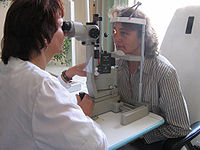
Photo from wikipedia
Purpose To investigate the level of compliance of children with refractive errors who are provided free spectacles, and to identify the reasons for non-compliance. Methods We systematically searched the PubMed,… Click to show full abstract
Purpose To investigate the level of compliance of children with refractive errors who are provided free spectacles, and to identify the reasons for non-compliance. Methods We systematically searched the PubMed, EMBASE, CINAHL, Web of Science, and Cochrane Library databases from the time these databases were established to April 2022, including studies published in English. The search terms were “randomized controlled trial” [Publication Type] OR “randomized” [Title/Abstract], OR “placebo” [Title/Abstract]) AND ((“Refractive Errors”[MeSH Terms] OR (“error refractive” [Title/Abstract] OR “errors refractive” [Title/Abstract] OR “refractive error” [Title/Abstract] OR “refractive disorders” [Title/Abstract] OR “disorder refractive” [Title/Abstract] OR “disorders refractive” [Title/Abstract] OR “refractive disorder” [Title/Abstract] OR “Ametropia” [Title/Abstract] OR “Ametropias” [Title/Abstract])) AND (“Eyeglasses” [MeSH Terms] OR (“Spectacles” [Title/Abstract] OR “Glasses”[Title/Abstract]) AND (“Adolescent” [MeSH Terms] OR (“Adolescents” [Title/Abstract] OR “Adolescence”[Title/Abstract]) OR “Child”[MeSH Terms] OR “Children”[Title/Abstract])). We only selected studies that were randomized controlled trials. Two researchers independently searched the databases, and 64 articles were retrieved after the initial screening. Two reviewers independently assessed the quality of the collected data. Results Fourteen articles were eligible for inclusion, and 11 studies were included in the meta-analysis. The overall compliance with spectacle use was 53.11%. There was a statistically significant effect of free spectacles on compliance among children (OR = 2.45; 95% CI = 1.39–4.30). In the subgroup analysis, longer follow-up time was associated with significantly lower reported ORs (6–12 vs. <6 months, OR = 2.30 vs. 3.18). Most studies concluded that sociomorphic factors, RE severity, and other factors contributed to children not wearing glasses at the end of the follow-up. Conclusion The combination of providing free spectacles along with educational interventions can lead to high levels of compliance among the study participants. Based on this study's findings, we recommend implementing policies that integrate the provision of free spectacles with educational interventions and other measures. In addition, a combination of additional health promotion strategies may be needed to improve the acceptability of refractive services and to encourage the consistent use of eyewear. Systematic review registration https://www.crd.york.ac.uk/PROSPERO/display_record.php?RecordID=338507, identifier: CRD42022338507.
Journal Title: Frontiers in Public Health
Year Published: 2023
Link to full text (if available)
Share on Social Media: Sign Up to like & get
recommendations!